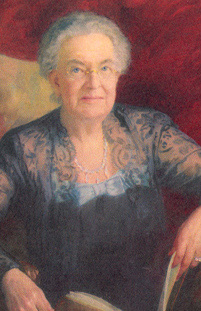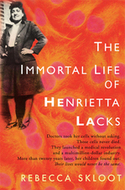 When I first started my independent academic laboratory in 1992, it was in a brand new facility across the parking lot from a then 40-year-old building named in honor of the woman to the right. I took on a big teaching load from day one and while I had some cash left from the $50,000 start-up package, I didn't hire a technician immediately. So it fell upon me to do all the ordering of the basic supplies to get the operation rolling. No problem, right? I ordered much of my own stuff as a postdoc so it should be no problem to get everything I need to start the lab from scratch.
When I first started my independent academic laboratory in 1992, it was in a brand new facility across the parking lot from a then 40-year-old building named in honor of the woman to the right. I took on a big teaching load from day one and while I had some cash left from the $50,000 start-up package, I didn't hire a technician immediately. So it fell upon me to do all the ordering of the basic supplies to get the operation rolling. No problem, right? I ordered much of my own stuff as a postdoc so it should be no problem to get everything I need to start the lab from scratch.
One of the most common buffers used in molecular and cell biology labs is "Tris," short for a base called tris(hydroxymethyl)aminomethane. By adding different amounts of hydrochloric acid to it, you can create buffers from pH 6.8 to pH 9 so it's pretty versatile.
So, I opened the old Sigma catalog (this was when companies were only just starting to get their catalogs online). There were five varieties of Tris and nine varieties of Trizma®, Sigma's brand of Tris base (there are now six and 15, respectively).
So which do I order? The ACS reagent grade >99.8%, the JIS special grade >99% or do I go for the BioUltra Trizma?
But the Bioultra Trizma comes in two forms, one for molecular biology and another for luminescence. I definitely needed a molecular biology grade tested RNase-free that I could also use for cell culture.
Hmmm, how 'bout the "Biotechnology Performance Certified, meets EP, USP testing specifications, cell culture tested, ≥99.9% (titration)."
And so, for each chemical I needed to start the lab I had to go through and evaluate why I needed one form over another, and what the difference was between all of the terminology.
When it came time to bring in the cultured cell lines for my work, I decided that I was going to start all of my cultures from an original, traceable stock obtained directly from a cell repository instead of the more common practice of soliciting colleagues around campus for hand-me-downs of their established lines. You never know where someone's cells have been, how long they might have been passaged, whether they have been cross contaminated, or if they have latent mycoplasma infections.
 So I knew I needed HeLa cells - those ones we're hearing all about these days from Rebecca Skloot's New York Times-bestselling book, The Immortal Life of Henrietta Lacks, about the 31-year-old rural black woman whose cervical carcinoma gave rise to the first immortalized human cell line.
So I knew I needed HeLa cells - those ones we're hearing all about these days from Rebecca Skloot's New York Times-bestselling book, The Immortal Life of Henrietta Lacks, about the 31-year-old rural black woman whose cervical carcinoma gave rise to the first immortalized human cell line.
The two most common vendors for original cell culture stock are the American Type Culture Collection (ATCC) and the Deutsche Sammlung von Mikroorganismen und Zellkulturen (DSMZ), or German Collection of Microorganisms and Cell Cultures. There are others, including major national research institutes, and dozens of other vendors have modified cells for a variety of specialized uses.
ATCC is a private, non-profit organization that traces its roots back to 1925 when scientists realized a need for a central laboratory that distributed certified strains of microorganisms. If you isolate your own cell line that you wish to make available to the scientific community, you can deposit it with ATCC and they will handle requests for it from other investigators, using sales fees to support their operation.
Not only does ATCC serve as a central repository but it also contributes to the continuity of the biomedical research enterprise. I had a physician-scientist colleague a few years back who was closing his research lab and moving to private oncology practice. But he had developed a series of very useful drug-resistant clonal populations of two, common human leukemia lines. These are very useful cells for investigating why cancer cells develop tolerance to drug therapy but since there would be no one left to distribute them, he deposited them with ATCC (example).
OK, so back to 1992: I open the ATCC catalog (again, before it was online) and, hmm, you've got HeLa cells (catalog designation CCL-2). Great. Let's order 'em up.
But then there are also HeLa 229 (CCL-2.1), and HeLa S3 (CCL-2.2).
Hrumph. I just want some freakin' HeLa cells - what's up with these other ones? They all kind of look the same, all from the same woman, all grown in the same medium.
So what the difference?
In her Los Angeles Times interview last month, Skloot remarked that the Lacks book began with a manuscript she was planning to meet the requirements of her MFA at the University of Pittsburgh:
"I was in class, and I got out a piece of paper and I wrote at the top 'Forgotten Women in Science,' " she remembers. She planned to do 12 essays. "Number 1, I wrote Henrietta Lacks, and then I was like, hmmm."
So over a series of posts this weekend, I wish to tell you about a woman in science indirectly related to HeLa cells. She may not necessarily qualify as a "forgotten woman of science" but her story is perhaps not well-appreciated today because her contributions occurred so long ago.
Florence Rena Sabin, MD (1871 - 1953), a daughter of a Colorado coal mining family, became a female pioneer in medicine and public health. With the simple notation of "S3" she is forever linked to the first clonal population of these cervical cancer cells from the poor Virginia tobacco farmer.
Image credit: Sabin color portrait from Women in the Rockefeller Archive Center
 Share / Save
Share / Save











Comments
Great hook. I'll be back for the complete story.
Posted by: Jamie Vernon | March 6, 2010 12:17 PM
I look forward to the next installment!
Posted by: Carpus | March 6, 2010 1:00 PM
You fucker! How can you leave us hanging like that?
Posted by: Comrade PhysioProf | March 6, 2010 1:14 PM
Don't worry, CPP, you won't have to go looking up 1950s papers yourself. I've just been working on this post in fits and starts throughout LungMutiny2010 and it got too long even when I tried to abbreviate it.
Thanks Carpus and Jaime. Hope the rest hold your interest.
Posted by: Abel Pharmboy | March 6, 2010 1:58 PM
I'll be waiting with impatience, myself....
Posted by: Luna_the_cat | March 6, 2010 4:28 PM
more! more!
Posted by: bioephemera | March 6, 2010 5:31 PM
Just cruel. I'm with PP.
Posted by: Pascale | March 6, 2010 6:42 PM
Nice intro. I'll be watching for the rest of this story. I've always loved narratives that combine the history with the science.
Posted by: chezjake | March 6, 2010 8:33 PM
You may be interested in the following article:
Capes-Davis A et al. (2010): Check your cultures! A list of cross-contaminated or misidentified cell lines. Int J Cancer. 2010 Feb 8 [Epub ahead of print]
Posted by: sparc | March 7, 2010 1:00 AM
Fabulous post -- I hope you continue. And, please, if the rest is as good, turn it into a book. Immortal Life might be a well-written book, and Henrietta Lacks may have been a good & worthy person, but a person of science she was not. All the attention on the person whose cells have been studied only shows the confusion of our society about what's important. It's the Florence Sabins who we need to know more about. A delightful intro for that subject here if you ask me.
Posted by: Albion Tourgee | March 7, 2010 10:08 AM
@Luna, BioE, Pascale, chezjake - thank you and I hope you'll now move on to Part II here. I'm just realizing it's a rather long post that I could have broken up even more. Part III will go up Monday and will describe the clonal isolation of HeLa S3. It's actually been a lot of fun putting this together.
@sparc - Yes, HeLa contamination is everywhere, still. Thanks so much for the heads-up on this latest paper.
@Albion - I'm glad you enjoy the post but please do take the time to read the Immortal Life. The author interspersed the family stories with some quite detailed chapters on the science and the stories behind the scientists. These chapters are well-annotated with the original literature as well, something you don't see in many books.
Posted by: Abel Pharmboy | March 7, 2010 10:59 PM